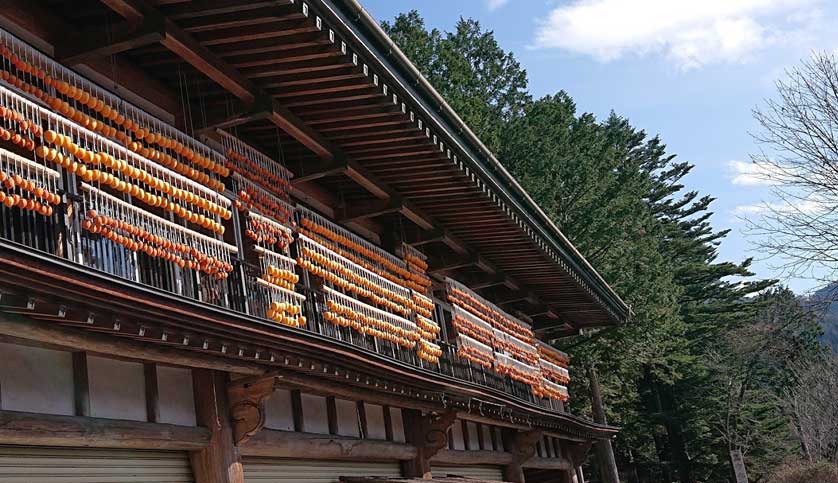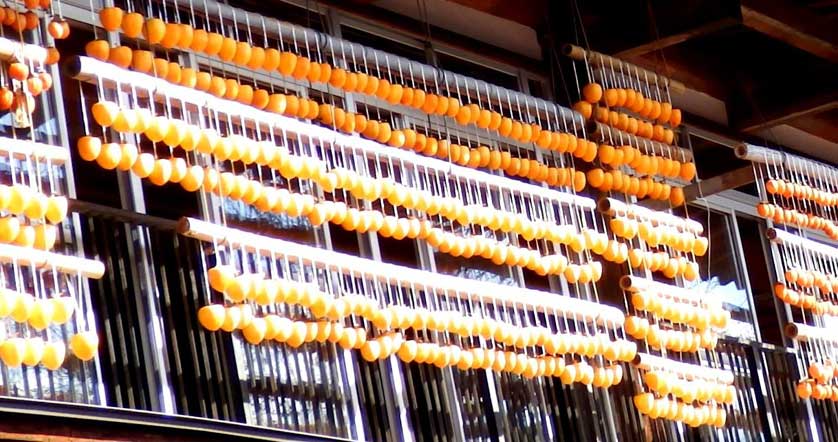Hoshigaki Japanese Dried Persimmons - A Traditional Japanese Winter Treat 干し柿
 |
| Hoshigaki hung up to dry in Japan |
Taking an autumn stroll pretty much anywhere in Japan, you will see trees bulging with kaki (persimmon fruits). Kaki are one of the most popular autumn fruits in Japan. Countryside farmers grow them but they can also be frequently found in suburban gardens.
Most of those kaki are of the amagaki variety, the sweet sort. After peeling, you can eat these fruits right away. They are delicious as fresh fruits.
From early December on, hoshigaki, dried persimmons, are also on sale. Akin to dried figs in Western countries, they are a popular winter sweet. In Japan, they are often served with a hot cup of green tea.
 |
| Kaki tree in autumn |
The Making of Hoshigaki
It may sound surprising but those sweet hoshigaki are made from quite bitter fruits. Besides those sweet amagaki type kaki ready to eat as a fresh fruit, there is another variety of kaki called shibugaki. It's those shibugaki from which hoshigaki are produced.
Shibugaki translates as 'astringent persimmon': persimmon with a bitter, pungent taste that seems to contract your mouth. Biting into such a fruit is quite unpleasant. (In fact, biting into an unripe sweet kaki has the same effect.)
Shibugaki trees are particularly common in cold, mountainous areas throughout Japan.
In the old days, when besides fresh fruit hardly any sweets were available in Japanese mountain areas, people had to find a way to get their sugar fix for the long winter months. Thus, they found a way to turn those bitter shibugaki into a delicious, nourishing sweet.
Hoshigaki are made today the same way as centuries ago. Shibugaki fruits are collected, then peeled by hand with the help of a knife. Right after peeling the fruits' stems are connected to a rope, often many fruits along one rope.
The ropes are then hung outside in a rain-protected place exposing the peeled fruits to direct sunlight and wind. Usually the protruding roofs of the farm houses serve to provide rain protection. Rain protection is important: if the peeled fruits get wet, they would start to rot.
Being in the usually bright and steady sunlight of the Japanese autumn, along with the usually gently breezes of the season turns the fruits from bitter to sweet. Every few days, they need to be massaged by hand to keep their texture even.
The fruits hang out to dry for about six weeks to two months. Then, they are taken down and placed onto straw mats and kept outside for another 10 days or so.
At the end of the process, the fruits have shrunk to about one fourth of their original weight, they have become considerably smaller. A sticky, greyish white substance covers them. That substance is fruit sugar.
The hoshigaki are now ready for consumption.
 |
| Persimmon (kaki) |
Purchasing Hoshigaki
Hoshigaki are a seasonal product. They are available in stores and markets only from early December to about late February or early March.
There a various kinds of hoshigaki on sale. The two main varieties are koro kaki which are solid, easy to cut and not too sweet and ampo kaki which are very soft and very sweet.
There are also considerable differences in the package sizes. Very common in supermarkets are packages of about 9 fruits. You can however also purchase large packs of the dry fruits tightly packed together. Those latter ones are usually all connected by one long, thin rope – the rope they were originally dried on.
Uses of Hoshigaki
Hoshigaki can be eaten as a snack just the way they are - as sweet dry fruits. The koro kaki variety is also often used in salads, cut up into smaller pieces and eaten as a snack with cheese and wine or used in cakes, cookies or other bakery products. There are also used in a wide variety of traditional Japanese confectionary.
 |
| Hoshigaki drying |
Ichida Kaki 市田柿
Ichida kaki (aka Ichidagaki) is the brand name for a type of koro hoshigaki from the former Shinano Province in today's southern Nagano Prefecture.
They are grown and prepared in the region around the small town of Takamori, located in the valley of the Tenryu River, right between the Kiso Mountains (aka the Central Japanese Alps) and the Akaishi Mountains (aka the Southern Japanese Alps).
There, the climate consists of hot and humid summers, cold winters and a long, dry autumn. Ideal for the production of hoshigaki. In fact, the town of Takamori calls itself proudly the 'home of hoshigaki'.
Ichida kaki are today the perhaps most popular hoshigaki brand in Japan. They are all grown and prepared on small local farms in the area, each pack carries the name and address of the farm its product originates from.
Ichida kaki typically have a sugar content of about 65% to 70%, one dried fruit weights about 20 gram.
Just as they work perfectly well as a Japanese winter snack, Ichida kaki make also for a fitting and delicious Christmas snack in Western environs.
 |
| Ichida kaki |
Buy Hoshigaki
You can purchase Ichida kaki conveniently from Goods from Japan. The product is usually only available in winter.
Purchase a range of Japanese foodstuffs and drinks from GoodsFromJapan.
Related
Furikake Tsukudani Rice Topping Kinshobai
by Johannes Schonherr
 |
| A small pack of Ichida kaki, containing nine fruits |
© GoodsFromJapan.com

No comments:
Post a Comment